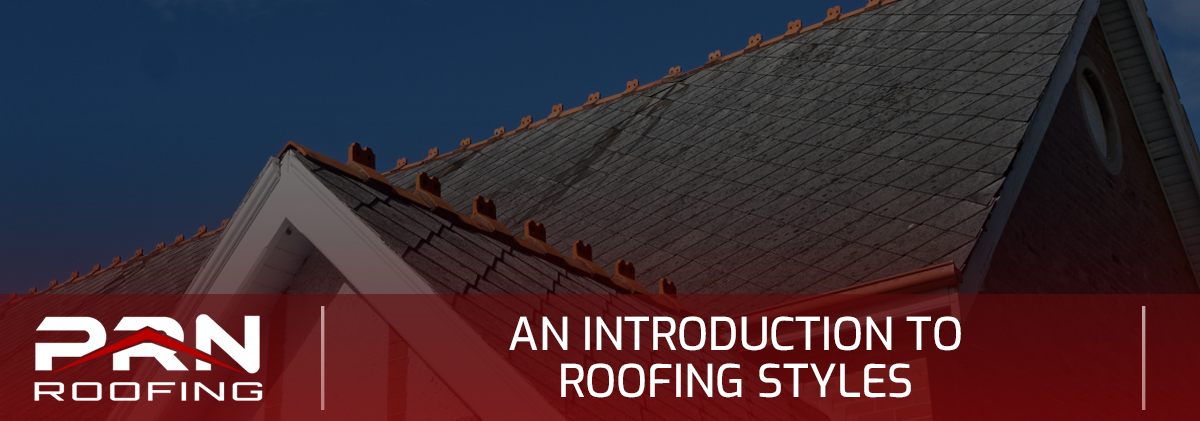Posts

An Introduction to Roofing Styles
Roofing styles have definitely changed over time, some due to preference, some due to technology, and some due to functionality. PRN Roofing, a top-rated residential and commercial roofer in Tuscaloosa, will review some of the common roof styles and their recommended uses in this blog post.
THE HISTORY OF ROOFING STYLES
As we’ve mentioned in a previous blog post, shelter is one of the fundamental things humans need to survive, along with food and clothing. And one of the most important components of a shelter is the roof over your head, so you’re not pelted with golf-ball sized hail or snowed on and end up freezing to death.
Shelters began very simply (like most of our inventions like the automobile for example) with just four sides and a simple roof. Roofs were constructed out of simple materials, such as sod and grass, mainly due to the fact that that was all that was around to choose from. Over time, humans began to construct roofs that were more aesthetically pleasing once the materials became more readily available. Clay began to be used and then tile and slate. Thatch and wood were added in the Middle Ages. Still, due to the hardships the majority of the population faced 1000 years ago, roofs remained simple and functional.
Enter King John of England who reigned from 1199 to 1216. Most famous for signing the Magna Carta reluctantly, which gave barons and churches rights, King John passed a little known law that outlawed thatch roofs in London and demanded citizens replace the existing thatch-roofed homes immediately to prevent fires. People had to come up with other materials, which they did. In the eighteenth century, we saw widespread use of clay tiles and in the nineteenth century, concrete tiles came into use.
The same evolution of roofing materials occurred in the United States as well, with early settlers using whatever was available to them — which was wood since forests were everywhere and seemingly endless. PRN Roofing in Tuscaloosa specializes in all roofing materials and styles. We install residential roofs and commercial roofs, as well as repair and replace residential roofing. We have extensive roofing expertise and experience. Contact us today!
[grid_row_open class=””][grid_col_open class=”” palm=”” tablet=”25%” desktop=”25%” center=””]

Flat Roof
Just as the name implies, this roof is flat and sits on top of the structure’s walls.
[grid_col_close][grid_col_open class=”” palm=”” tablet=”25%” desktop=”25%” center=””]

Shed roof
Basically, the flat roof at a slight angle, usually about 10 to 30 degree angles.
[grid_col_close][grid_col_open class=”” palm=”” tablet=”25%” desktop=”25%” center=””]

Gambrel Roof
Think of a triangle over your building with two roof pieces coming together at an angle at the top.
[grid_col_close][grid_col_open class=”” palm=”” tablet=”25%” desktop=”25%” center=””]

Hipped roof
Hipped roofs are basically modified gable roofs where all four sides of the building have a pitch roof now.
[grid_col_close]
Most other roof types you’ll see are combinations and/or variations of these four styles of roofs. Some of our favorites include:
[grid_row_open class=””][grid_col_open class=”” palm=”” tablet=”33%” desktop=”33%” center=””]

Gambrel Roof
Brought over by the Dutch, a gambrel roof is a gable roof with two pitches, most commonly seen on the majority of barns in America.
[grid_col_close][grid_col_open class=”” palm=”” tablet=”33%” desktop=”33%” center=””]

Saltbox Roof
A modified gable roof is characterized by one side of the roof being overly long and extended in the back of the house.
[grid_col_close][grid_col_open class=”” palm=”” tablet=”33%” desktop=”33%” center=””]

Jerkinhead Roof
A jerkinhead roof is a clipped version of the hipped gable. The gable is clipped short and is turned down instead of rising to a point.
[grid_col_close][grid_row_close]
[grid_row_open class=””][grid_col_open class=”” palm=”” tablet=”33%” desktop=”33%” center=””]

Mansard Roof
A mansard roof has two slopes on each of the four sides. The lower slope is steep.The upper slope has a low pitch and is not easily seen from the ground.
[grid_col_close][grid_col_open class=”” palm=”” tablet=”33%” desktop=”33%” center=””]

Butterfly Roof
Yes, it resembles a butterfly. The roof dips down in the middle and slopes upward away from each other. Picture a gable roof but upside down.
[grid_col_close][grid_row_close]
PRN Roofing is the best local roofing contractor in Tuscaloosa. We offer residential and commercial roof installation, roof replacement, roof maintenance, and roof repairs. Contact us today!
THE ROOF STYLES OF TODAY
There are four basic roof styles:
- Flat roof. Just as the name implies, this roof is flat and sits on top of the structure’s walls.
- Shed roof. Basically, the flat roof at a slight angle, usually about 10 to 30 degree angles.
- Gable or double-pitched roof. Think of a triangle over your building. The double-pitched name comes from the fact that a gable roof is basically two shed roofs stuck together with the same angle, or pitch. The gable roof traditionally was the most popular in Colonial America and has become synonymous with New England. It was easy to build and very functional.
- Hipped roofs. Hipped roofs are basically modified gable roofs where all four sides of the building have a pitch roof now.
Most other roof types you’ll see are combinations and/or variations of these four styles of roofs. Some of our favorites include:
- Gambrel roof. Brought over by the Dutch, a gambrel roof is a gable roof with two pitches. The lower section of the roof slopes gently up. Then, the roofline angles in to form a steeper pitch.This style is what you’ll see on the majority of barns in America.
- Saltbox roof. A modified gable roof, the saltbox roof is sometimes called a house style. A saltbox roof is very distinctive and characterized by one side of the roof being overly long and extended in the back of the house, which tends to be on the north side which protected the homeowners from harsh winters since this roof was built in the early colonial period as well. often on the north side to protect interiors from harsh New England winter weather. The name and shape of the roof comes from the fact that the roof closely resembles the slant-lid storage box that colonists used for salt. Salt was the most common preservative in colonial times, and everyone had a storage box for it.
- Jerkinhead roof. A jerkinhead roof is a clipped version of the hipped gable. The gable is clipped short and is turned down instead of rising to a point. This style of house was actually popular in the 1920s and 1930s in America.
- Mansard roof. Think dramatic when you think of the mansard roof. A mansard roof is characterized by two slopes on each of the four sides. The lower slope is steep that often appears like a vertical wall with dormers.The upper slope has a low pitch and is not easily seen from the ground. There are no gables present. This roof is most famously seen on the Louvre Museum in Paris and is characteristic of the French Renaissance. However, this roof experienced another revival in France under Napoleon III in the 1850s. These roofs created living spaces in attics, which is why they became popular in America as well from around 1860s to 1880s. In the United States, you can still see these roofs in some apartment buildings and restaurants. However, if you visit any major city in Europe, you’ll see these roofs everywhere.
- Butterfly roof. Yes, it resembles a butterfly. We’ve all seen these roofs where the roof dips down in the middle and slopes upward away from each other. Picture a gable roof but upside down. The butterfly room is a modern invention.
The saying goes that your pet resembles you. You could say the same thing about roofing styles as well. From the simple to the ornate, roofs can make a bold statement. These are just some of the dozens of styles of roofs.
Most homeowners today are seeking the best roofing materials and styles that are attractive, inexpensive, low-maintenance, and long-lasting, as well as environmentally-friendly. But how do you know which roofing style will best fit you? PRN Roofing, the best roof replacement company in Tuscaloosa, offers up some tips to choose your roofing style.
TIPS FOR CHOOSING ROOFING STYLE
- What kind of material will you be using?
- Will your roof need any type of special installation?
- Do you get a lot of rain and snow? If so, a roof like the flat roof may not be for you.
- Do you live in a windy area? Then perhaps the standard shed roof is not for you.
- How big is your home?
When kids are asked to draw a home, the vast majority of them draw a home with a gable roof. These are the most popular roofing types because they are the most adaptable style, very energy efficient, and highly storm resistant. A composite style is also very popular as you can then mix and match for functionality and aesthetic appeal.
PRN Roofing will offer up recommendations and estimates for your roof replacement. We understand that a roof is no longer just a shelter — it represents you as well. If you need your current residential roof inspected, give us a call. If you need your business painted, we offer exterior painting services as well. We clean gutters, and we install siding, matching your siding to your roof. PRN Roofing has a solution to any of your roofing needs. Contact us today for a free estimate!






